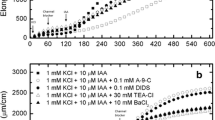Summary
-
1.
Comparative measurements of the geotropic curvature and of the auxin distribution in the same gravitational field were performed to test the relation between the transversal growth substance gradient and the observed tropic reaction. In order to examine whether the extent of the curvature is fully explaned by the asymmetry of the auxin distribution in the opposite halves of the stimulated organ, comparable growth substance gradients were produced in vertical hypocotyls by supplying them asymmetrically with synthetic auxin from external sources. After identical times the auxin content in both halves of the organ was measured and compared with the curvatures produced. The general result of all these experiments, repeated under various conditions, is the finding that a given transversal auxin concentration gradient produces much stronger curvatures in organs exposed to the transversal gravitational field than in those left in the vertical position. This observation confirms our assumption that the geotropic stimulus, in addition to changing the auxin distribution in the stimulated organ, also strongly influences its sensitivity to the growth substance.
-
2.
Further comparative measurements revealed still another drastic effect of the geotropic stimulus. Hypocotyls put in the horizontal position absorb considerably more auxin supplied to them laterally than comparable organs do in the vertical position. This effect concerns chiefly the upper half of the stimulated stem.
-
3.
The last experiments of this research deal with the problem of the de novo production of growth substance under the influence of the geotropic stimulus. In the growing zone of intact seedlings the content of endogenous auxin is considerably increased under the influence of the transversally acting gravitation. This effect, however, is completely missing in plants whose natural auxin sources (cotyledons, plumula) have been removed by decapitation. Therefore the possibility has to be considered that the rise of the auxin-level observed in the geotropicaly stimulated zone may be due not to a de novo formation of growth substance but to the increased absorption capacity of the tissue for auxin already present in its natural sources.
Similar content being viewed by others
Literatur
Borris, H.: Die Beeinflussung des Streckungswachstums durch Salze I. Mitt. Jb. wiss. Bot. 85, 732–769 (1937).
Brauner, L.: Versuche zur Analyse der geotropischen Perzeption. V. Mitt. Planta (Berl.) 69, 299–318 (1966).
—, Böck, A.: Versuche zur Analyse der geotropischen Perzeption. IV. Mitt. Planta (Berl.) 60, 109–130 (1963).
—, Brauner, M.: Versuche zur Analyse der geotropischen Perzeption. II. Mitt. Planta (Berl.) 56, 416–437, (1961).
——: Versuche zur Analyse der geotropischen Perzeption. III. Mitt. Planta (Berl.) 58, 301–325 (1962).
—, Hager, A.: Versuche zur Analyse der geotropischen Perzeption. I. Mitt. Planta (Berl.) 51, 115–147 (1958).
Cholodny, N.: Wuchshormone und Tropismen bei den Pflazen. Biol. Zbl. 47, 604–626 (1927).
Fitting, H.: Untersuchungen über Chemodinese bei Vallisneria. Jb. wiss. Bot. 67, 427–596 (1928).
Ganot, D., Reinhold, L.: The “acid growth effect” and geotropism. Planta (Berl.) 95, 62–71 (1970).
Gunder, W.: Chemische und physikalisch-chemische Vorgänge bei geischer Induktion. Jb. wiss. Bot. 78, 623–664 (1933).
Libbert, E.: Die Wirkung der Alkali- und Erdalkaliionen auf das Wurzelwachstum unter besonderer Berücksichtigung des Ionenantagonismus und seiner Abhängigkeit von Milieufaktoren, Planta (Berl.) 41, 396–435 (1953).
Metzner, P.; Zur Kenntnis der Stoffwechseländerungen bei geotropisch gereizten Keimpflanzen. Ber. dtsch. bot. Ges. 52, 506–522 (1934).
Overbeek, J. van, Olivo, G.D., de Vásquez, E. M. S.: A rapid extraction method for free auxin and its application on geotropic reactions of bean seedlings and sugar-cane nodes. Bot. Gaz. 106, 440–451 (1944).
Schmitz, H.: Über Wuchsstoff und Geotropismus bei Gräsern. Planta (Berl.) 19, 614–635 (1933).
Went, F. W.: On growth-accelerating substances in the coleoptile of Avena sativa. Proc. kon. ned. Akad. Wet. 30, 10–19 (1927).
Author information
Authors and Affiliations
Rights and permissions
About this article
Cite this article
Brauner, L., Diemer, R. Über den Einfluß der geotropischen Induktion auf den Wuchsstoffgehalt, die Wuchsstoffverteilung und die Wuchsstoffempfindlichkeit von Helianthus-Hypokotylen. Planta 97, 337–353 (1971). https://doi.org/10.1007/BF00390213
Received:
Issue Date:
DOI: https://doi.org/10.1007/BF00390213




